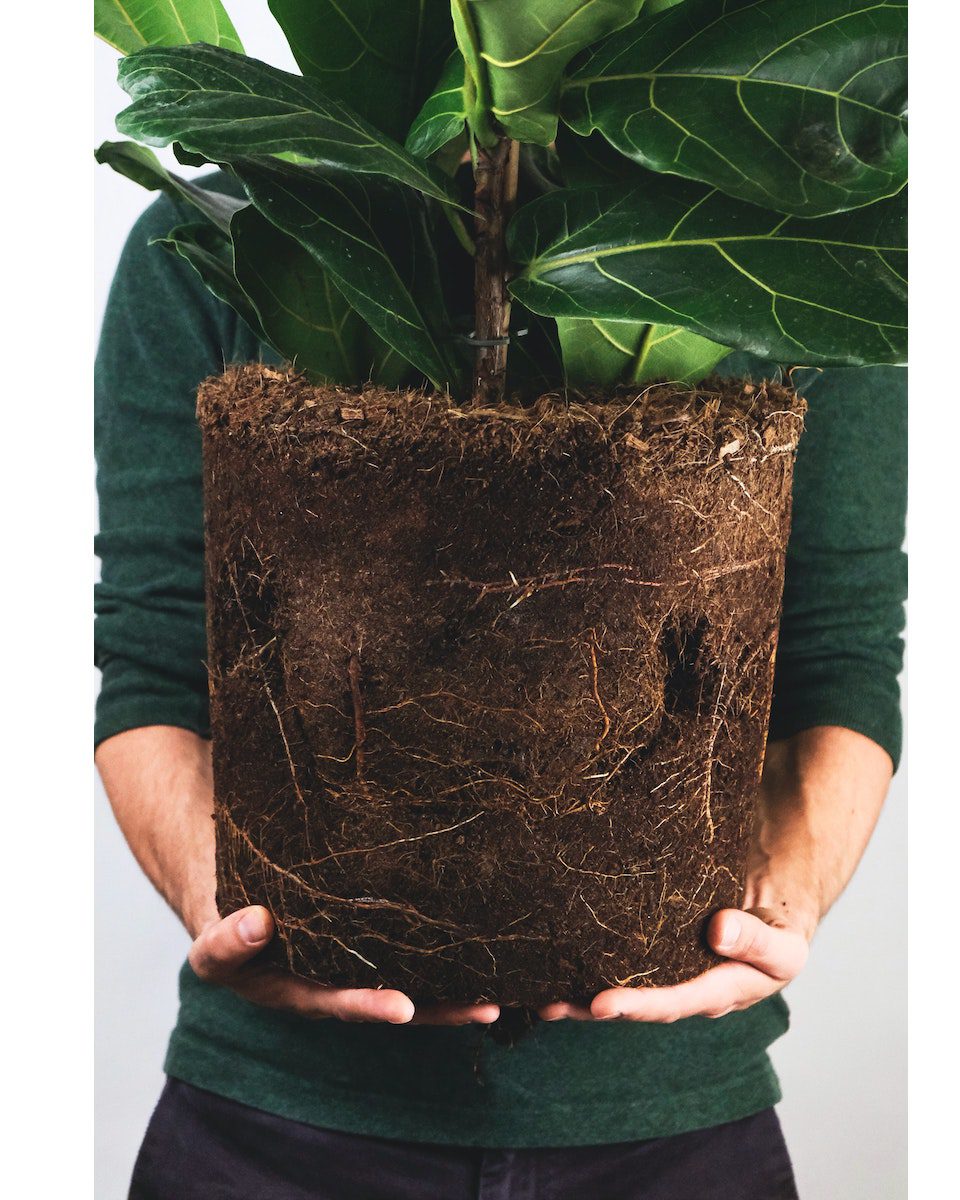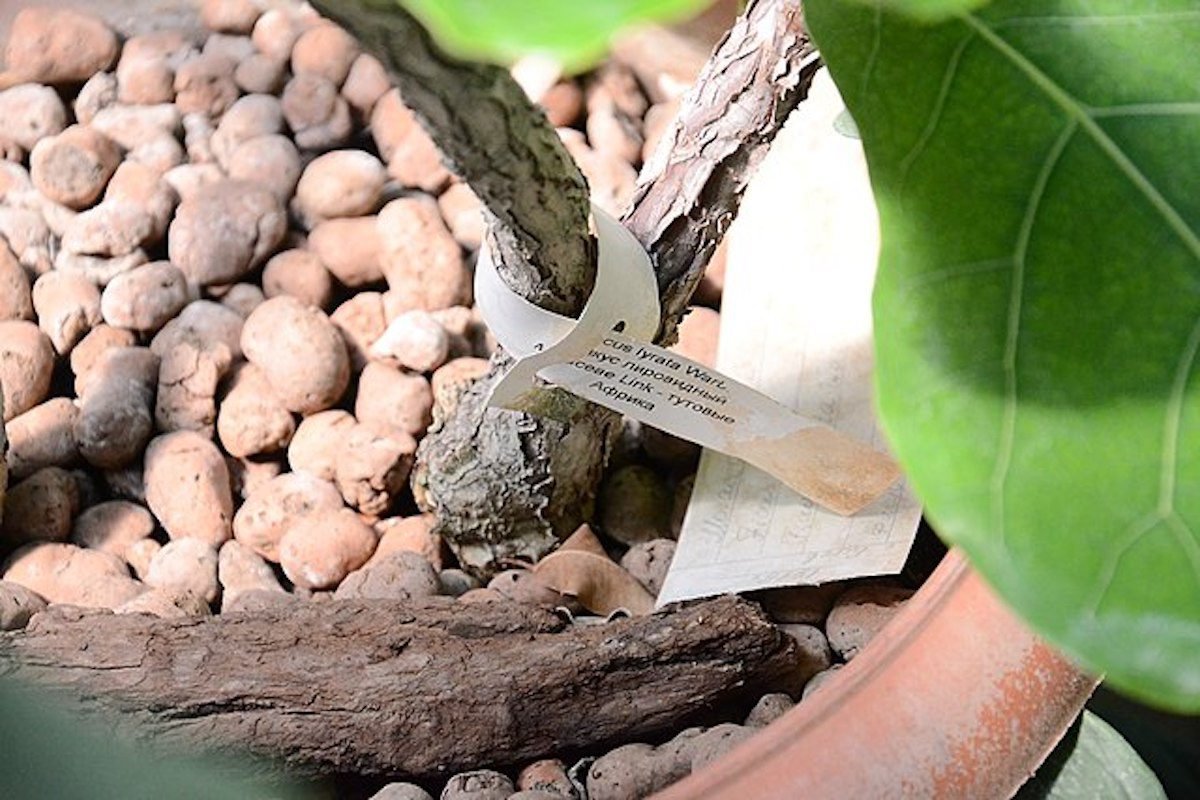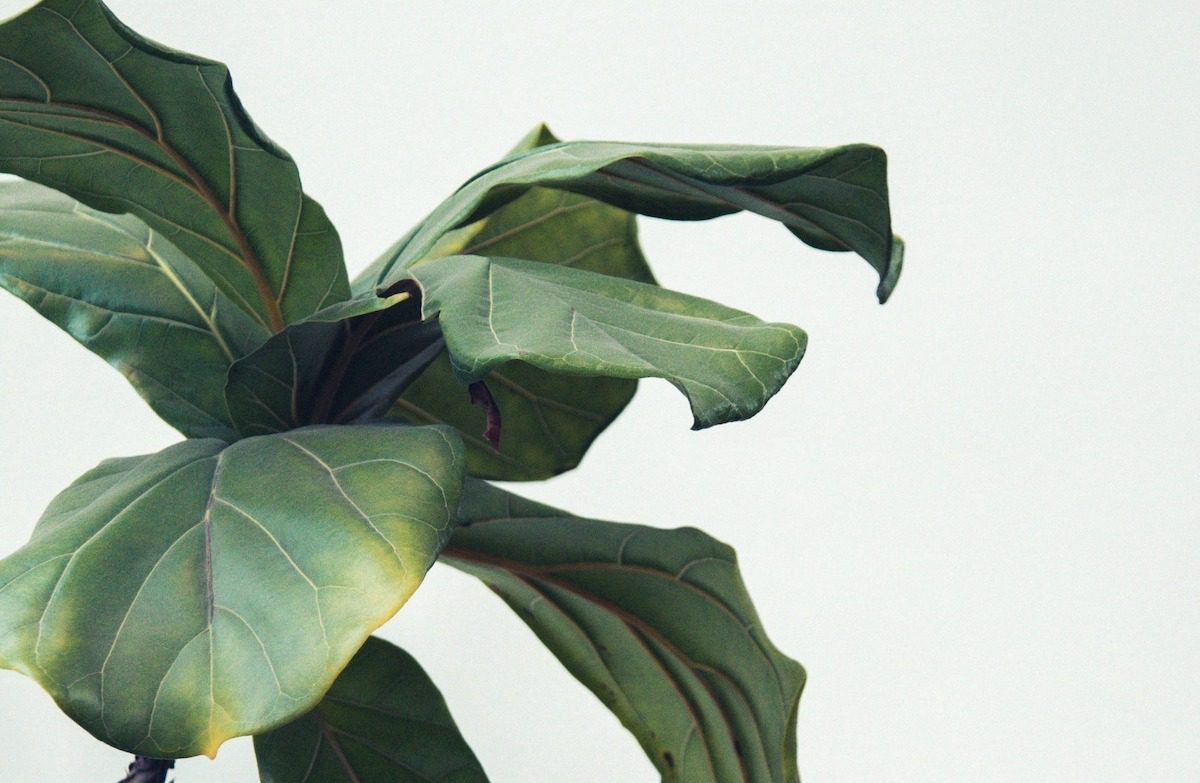The fiddle leaf fig is one of those rare mainstream-popular plants that has made it to the grocery store. We love the plants for their poetic namesake and versatility (they grow just as big as you want them to), but it’s surprisingly easy to overwater them. Easier said than done, we know! A slip of the hand, a bit of smothering love, and – 😳
Fiddle leaf figs prefer to dry out completely between waterings since they have long, fibrous roots that reach deep into the pot to absorb any moisture that’s present. These deep roots let the plant tolerate a week or two between waterings, depending on its age and size, but also suffer when left in excess water. We’ll walk you through the do’s and dont’s of how to save an overwatered fiddle leaf fig in this article.

signs of an overwatered fiddle leaf fig
Fiddle leaf figs have thick trunks that store moisture and fibrous roots that reach down several inches into the soil, allowing them to go some time in between waterings. Seriously – longer than you might think!
When the plant is getting too much moisture, its signature, deep-veined leaves will show signs of stress below the soil level. Some of these signs include drooping, yellowing, and brown splotching or spotting – the equivalent of your fig tree calling 911 🚨!
Additional symptoms of stress from excess water include edema (the over-saturation of a leaf with water), root rot, and fungal infections. Fungus gnats often start buzzing around after an overwatering, feeding on the fungal growth in the soil and laying eggs in the wet soil. Here are other signs of an overwatered fiddle leaf fig:
- Drooping leaves. This happens when your fig sits in moist soil for a prolonged period, which prevents enough oxygen getting to the leaves. Drooping leaves are often the first sign of an overwatered fig – in itself, not a huge issue, but it can lead to bigger problems.
- Edema. Edema is the moisture stress a plant undergoes from overwatering. It occurs when the roots of a plant absorb more water than it can transpire through its leaves, which retain the excess moisture. When the leaves’ cells are saturated, they burst, damaging the tissue and leaving reddish brown splotches across the leaf.
- Yellowing leaves. When you notice the leaves of a fiddle leaf fig beginning to yellow, it usually means the dreaded root rot has sunk in. We’ll call it stage III – pretty bad, but not irreversible. Rotten roots are unable to absorb water, which limits the supply of moisture and essential nutrients to your plant and shuts down photosynthesis processing. Yellowing leaves from root rot typically shows on the underside of leaves before the top, so keeping a close eye on your plant can help stop excess damage.
- Brown spots. Brown or black speckling on the leaves of your fiddle leaf fig is another sign of root rot. Also resulting from stress at the cellular level, brown and black spots usually mean a more advanced stage of root rot has set in – stage IV. If more than 50% of the leaves are affected by the speckles, your plant is likely dying.
- Leaf drop. Unhappy fiddle leaf figs may drop leaves when they’re dehydrated, and this can happen before or after their leaves show changes in color. If your plant is dropping leaves, check the soil to see if it’s bone-dry.
- Fungal growth. Fungal growth in your plant’s soil may also be the cause of wilting or yellowing leaves. Fungus grows well in moist, dark conditions, and can damage roots and stem tissue if left unchecked.
- Fungus gnats. Fungus gnats breed in moist houseplant soil that is host to fungus. When the gnats hatch, they feed primarily on fungus. They might also make an unhappy appetizer of your plant’s roots.
how to save a fiddle leaf fig plant after overwatering
If all that sounds, well, dire – it is, plant people! But, an overwatered fiddle leaf fig showing any of the signs mentioned above can be saved. There are a few things you can do depending on the extent of the damage, but all of them involve letting your plant dry out and recover from the stress.
dry out the soil completely if just wet
If the plant is just looking lifeless and the soil looks too wet, allow the soil to dry out completely before watering it again. Then, adjust your schedule to space out waterings a little more. If it helps, keep track of the soil moisture content over a month, as well as the watering dates, until you get a good idea of how quickly, or slowly, the soil dries. This will vary, however, based on the size of the plant, the size of the pot, the amount of light the plant gets, as well as the time of year.
change the pot if necessary
There are many ways that repotting your fiddle leaf fig can help prevent damage to your plant’s roots and foliage from overwatering. Fiddle leaf figs have long, fibrous roots that like well-draining soil. This helps them reach moisture deep in the soil, which allows the plant to thrive between waterings. Pots that don’t have drainage holes will accumulate water and saturate the soil with moisture, so be sure your fiddle leaf fig is planted in a container with one of these little holes! Ideally, use a liner pot with several drainage holes in addition to an outer pot with a drainage hole and tray.
The size of the pot will make a difference in regulating the soil moisture as well. A large pot will give the plant more room to stretch its roots and drain the soil, but it will also hold more moisture, and for a longer period of time. If your plant is sitting in an oversized pot with too much soil around its roots, move it to a smaller one so it will drain more efficiently. If the roots aren’t damaged, allow the fiddle leaf time to dry out before transplanting it, since you don’t want to shock your already-stressed baby!
remove from the soil if root rot
Root rot is like the cancer of the indoor plant world 🥺. It kills plants left and right, but if it’s caught early enough, it can be treated, and no lives need be lost. If you have identified root rot at the base of your fiddle leaf fig, this is how to save it:
- Lift the plant from the soil and use sterile garden shears to snip away any mushy, damaged roots that appear brown or black in color.
- Treat the remaining roots with root supplement.
- Transplant the fiddle leaf into an appropriate-sized pot with drainage holes, and fresh, well-draining potting soil.
remove from the soil if fungal growth
More irritating than life-threatening is fungal growth in your fiddle leaf fig’s soil: If untreated though, the compound problems of fungus, the fungus gnats that feed on it, and root rot – will kill your plant. If fungus is your main problem, here’s what to do:
- Find a pot that’s the right size for your fiddle leaf fig that the soil drains well and has drainage holes.
- Lift your fiddle leaf fig from the infected soil and cut away any visibly damaged roots with sterile shears.
- Shake all soil free of your plant’s roots to remove fungus.
- Treat the root tips with a root supplement to support regeneration.
- If using the same pot you started with, empty it completely of soil and scrub it down thoroughly inside and out to remove fungus and bugs.
- Plant the fiddle leaf in fresh potting soil, and move the pot to a location that gets lots of bright, indirect light and good aeration (a fan in the room will help prevent fungal growth).
tips to avoid overwatering you fiddle leaf fig
Sometimes we all need reminders on best practices. Once your overwatered fiddle leaf fig has dried out and recovered, adjust your watering schedule based on the problem(s) you encountered. Keep an eye on your plant’s growing environment (is there air flow? Enough sunlight? etc) and how much water you’re really giving it. For a fiddle leaf fig, a moisture meter is a big help in making sure your plant’s soil is dry enough at the time you go to water it. Here are a few things to keep in mind when rehabilitating your fiddle leaf fig:
- Check the light and temperature conditions. Both of these factors affect soil moisture levels. When your plant is drowned in a warm, sunny room, the water in iits soil will evaporate faster. When your plant is chilling in darker, cooler conditions, water won’t evaporate from the soil as quickly. The watering schedule for a plant in light will be different from one in shade. The time of the year will also affect the plant, as it will absorb more water during the brighter, warmer growing season, requiring more frequent waterings than during the cooler, darker winter period of dormancy.
- Use a soil moisture meter. Moisture meters penetrate the top layer of soil and sense how wet the soil is at the mid and bottom layer of the pot as well. If you have a big fig, you’ll have a big pot! While the top couple of inches of soil in large containers may be dry to the touch, that’s often not the case for the soil mid- and deep-pot. Use a moisture meter before you water your fiddle leaf to make sure you’re giving your plant exactly what it needs.
- Get to know your fiddle leaf fig personally. Each plant has different needs, so getting to know your individual fiddle leaf fig will go a long way in determining its watering needs. Smaller plants may need to be given less water more frequently, say once a week, and larger ones usually prefer more water once every 2 or 3 weeks. The environment and growing conditions will play a part in your plant’s ideal watering schedule as well, so be consistent and adjust as needed.
- Drainage, drainage, drainage. No matter the quirks of your particular fiddle leaf fig, chances are that it likes well-draining soil that retains some moisture. Improving drainage for your plant is the best way to prevent root rot. If you make your own soil mixture, a 50/50 mix of potting soil and coarse materials like sand, orchid or pine bark, coco coir, LECA, or sphagnum moss will keep the soil aerated and well-draining, with less matter to absorb and saturate with water. A succulent potting mix can be a good choice for a fiddle leaf fig. Soil also becomes compacted over time, so consider using bamboo sticks to poke holes in the soil from time to time to incorporate oxygen and help the water drain through.

- Get your fiddle leaf fig off to a good start. Fiddle leaf figs are good candidates to be grown in LECA, a soilless growing medium that keeps the plant’s roots dry while providing them with slow, consistent irrigation. It’s relatively easy to grow plants in LECA, but it’s even easier if you start cuttings in the medium and go from there to limit the risk of transplant shock.
More about watering plants
- How Often To Water Dracaena (Including Snake Plants)
- How to Use Leca for Plants: Step-by-Step Guide with Pictures
- How To Save An Overwatered Snake Plant
- How Often To Water Pothos Plants (And When To Cut Back)
- How Often To Water Monstera Plants
- 11 Plants That Don’t Need Drainage And How To Care For Them
- Save Your Overwatered Monstera In 4 Steps (And How Not To Do It Again)



